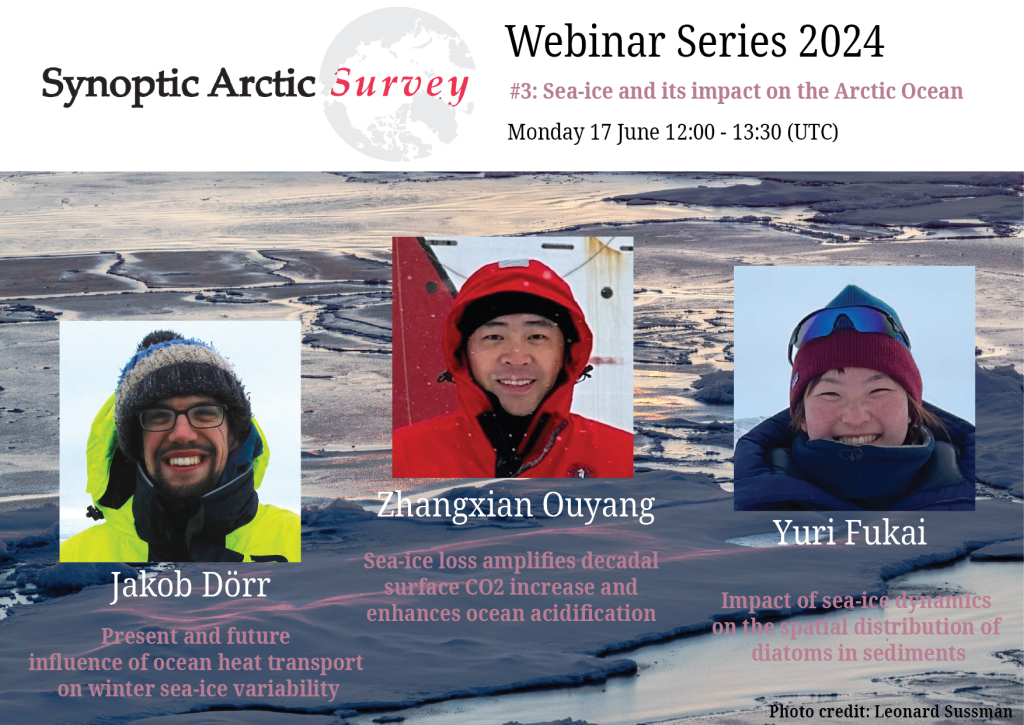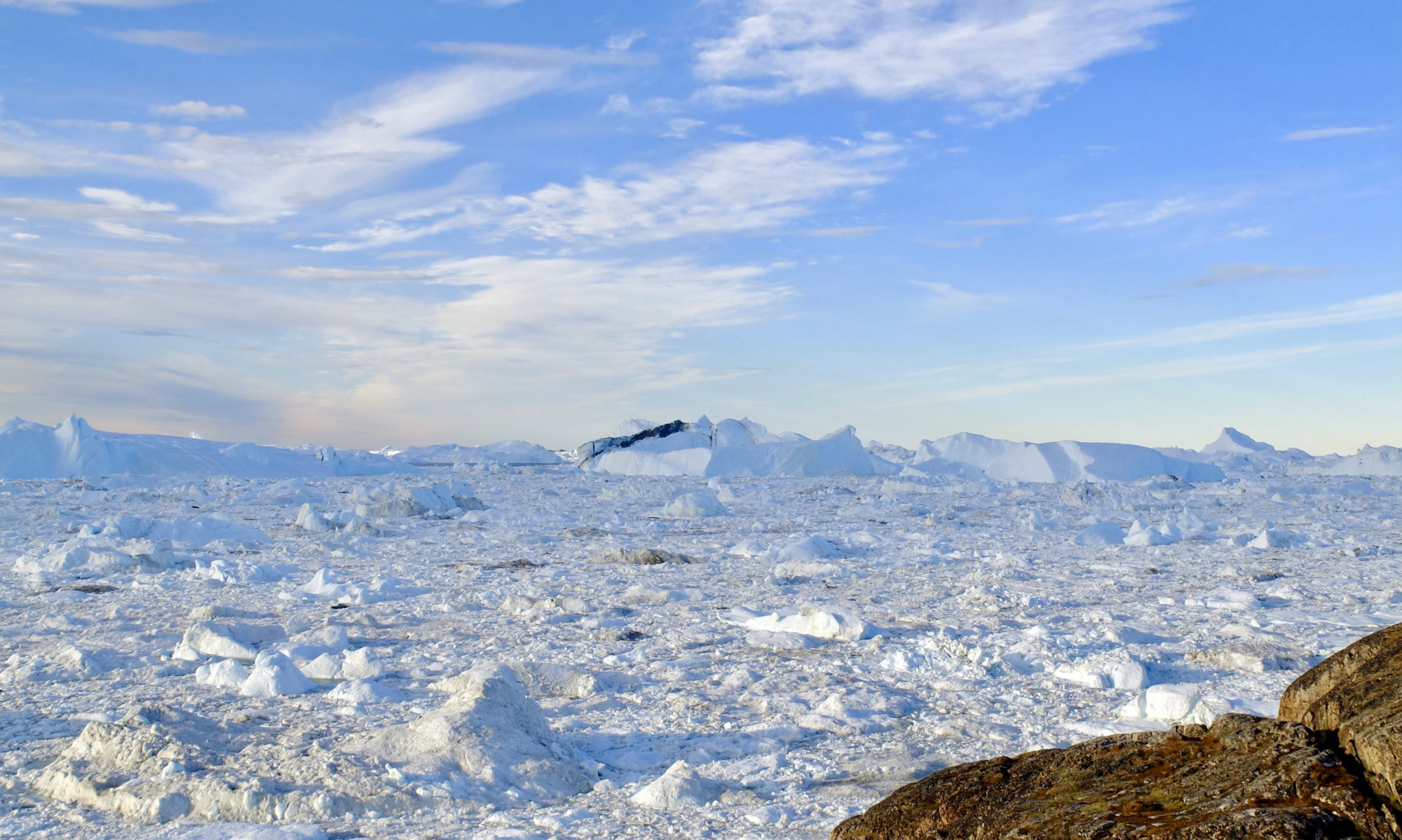Zoom webinar #3 2024: on Monday 17 June, 12:00 – 13:30 UTC

The Synoptic Arctic Survey (SAS) aims to map the present states and ongoing changes of the Arctic Ocean ecosystem, carbon cycle and associated hydrography. It does so by enhancing ongoing ocean monitoring with ship-based measurements.
This webinar showcases how the characteristic sea-ice in the Arctic Ocean is varying, and how changes in sea-ice cover affect both the global carbon cycle and Arctic marine ecosystems. It will be moderated by Are Olsen, the co-chair of the SAS scientific steering committee, who will also give a brief introduction to the SAS initiative. There will be three solicited talks with room for questions and discussions:
-
- Jakob Dörr – Post doc at University of Bergen, Norway
- Present and future influence of ocean heat transport on winter Arctic sea-ice variability
- Zhangxian Ouyang – Researcher at University of Delaware, USA
- Sea-ice loss amplifies decadal surface CO2 increase and enhances ocean acidification in the western Arctic Ocean
- Yuri Fukai – Post doc at JAMSTEC, Japan
- Impact of sea-ice dynamics on the spatial distribution of diatoms in sediments of the Pacific Arctic Region
- Jakob Dörr – Post doc at University of Bergen, Norway
The webinar will take place in Zoom. If you would like to join the webinar, please register to receive the meeting link:
https://skjemaker.app.uib.no/view.php?id=17315580
Abstracts of the presentations in this webinar
Present and future influence of ocean heat transport on winter Arctic sea-ice variability by Jakob Dörr
The recent retreat of Arctic sea ice is overlaid by strong internal variability on all timescales. In winter, sea-ice retreat and variability are currently dominated by the Barents Sea, primarily driven by variable ocean heat transport from the Atlantic. It is projected that the future loss of winter Arctic sea ice spreads throughout the Arctic Ocean and, hence, that other regions of the Arctic Ocean will see increased sea-ice variability. It is, however, not known how the influence of oceanic drivers on regional winter sea ice variability will change. We analyze and contrast the present and future link between Pacific and Atlantic OHT and the winter Arctic sea-ice cover using simulations from seven single-model large ensembles of climate models. We find that for the recent past, sea ice variability in the Atlantic and Pacific sector of the Arctic Ocean is influenced by ocean heat transport through the Barents Sea and Bering Strait, respectively. Models agree on a gradual expansion of the footprint of the Pacific and Atlantic inflows, covering the whole Arctic Ocean by 2050-2079. We also analyze model differences to determine which factors are important to correctly simulate to capture the changing impact of OHT in the warming Arctic. Finally, we use a causal method to compare the relative influence of atmospheric and oceanic drivers on sea ice variability in the Barents and Kara Seas, and how it is projected to change in the future.
Further reading:
https://agupubs.onlinelibrary.wiley.com/doi/10.1029/2023JC019900
https://agupubs.onlinelibrary.wiley.com/doi/full/10.1029/2024GL108195
Sea-ice loss amplifies decadal surface CO2 increase and enhances ocean acidification in the western Arctic Ocean by Zhangxian Ouyang
Ocean uptake of CO2 from the atmosphere provides a crucial link and negative feedback for global climate change. This process slows the increase of this greenhouse gas in the atmosphere and potentially reduces the rate of global warming. The Arctic Ocean, as a bellwether for climate change, has experienced dramatic physical and ecological changes including rapid warming and sea-ice retreat. These changes are likely to continue to modify the physics, biogeochemistry, and ecology in the Arctic Ocean and the relevant trends and feedback of sea surface CO2 and ocean acidification (OA) are not fully understood yet. Here, we report the decadal changes in sea surface pCO2, pH and saturation state of CaCO3 (Ω) from 1994 to 2020 in the western Arctic Ocean. We find that summer pCO2 in the Canada Basin increased at twice the rate of atmospheric CO2 increase and ocean acidification rates are three to four times higher than in other ocean basins. Warming and sea ice loss in the basin have strengthened the pCO2 seasonal amplitude, resulting in the rapid decadal increase. In addition, sea ice melt exposes seawater to the atmosphere and promotes rapid uptake of atmospheric carbon dioxide, lowering its alkalinity and buffer capacity and thus leading to sharp declines in pH and Ω.
Further reading:
https://www.nature.com/articles/s41558-020-0784-2
https://www.science.org/doi/full/10.1126/science.abo0383
Impact of sea-ice dynamics on the spatial distribution of diatoms in sediments of the Pacific Arctic region by Yuri Fukai
The Pacific Arctic region is characterized by seasonal sea-ice, the spatial extent and duration of which varies considerably. In this region, diatoms are the dominant phytoplankton group during spring and summer. To facilitate survival during periods that are less favorable for growth, many diatom species produce resting stages that settle to the seafloor and can serve as a potential inoculum for subsequent blooms. Since diatom assemblage composition is closely related to sea-ice dynamics, detailed studies of biophysical interactions are fundamental to understanding the lower trophic levels of ecosystems in the Pacific Arctic. One way to explore this relationship is by comparing the distribution and abundance of diatom resting stages with patterns of sea-ice coverage. In this study, we quantified viable diatom resting stages in sediments collected during summer and autumn 2018 and explored their relationship to sea-ice extent during the previous winter and spring. Diatom assemblages were clearly dependent on the variable timing of the sea-ice retreat and accompanying light conditions. In areas where sea-ice retreated earlier, open-water species such as Chaetoceros spp. and Thalassiosira spp. were abundant. In contrast, proportional abundances of Attheya spp. and pennate diatom species that are commonly observed in sea-ice were higher in areas where diatoms experienced higher light levels and longer day length in/under the sea-ice. This study demonstrates that sea-ice dynamics are an important determinant of diatom species composition and distribution in the Pacific Arctic region.
Further reading:
https://agupubs.onlinelibrary.wiley.com/doi/10.1029/2021JC017223

